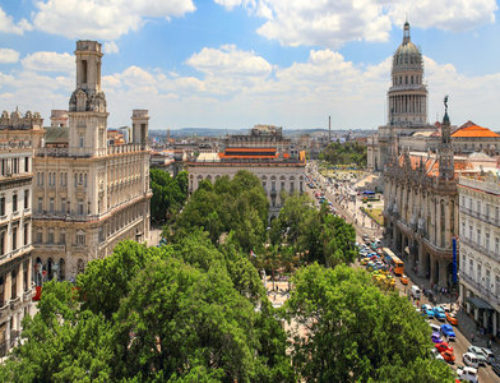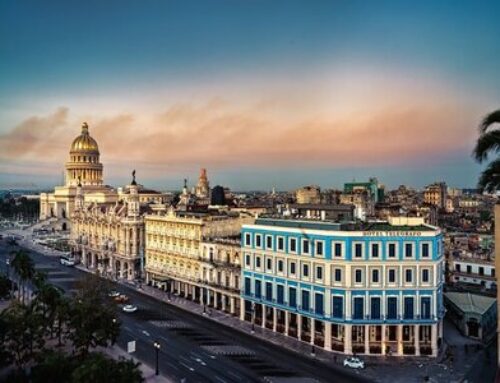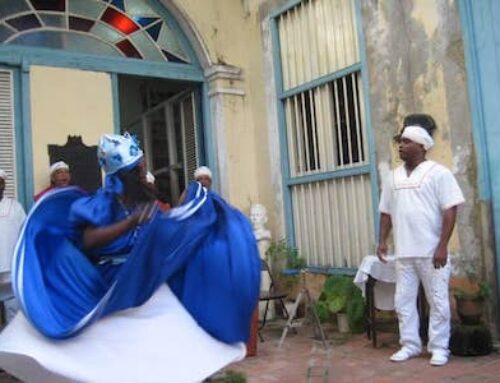In July, AltruVistas and College Track brought a group of students from New Orleans—all of whom have experienced the impact of Hurricane Katrina on their lives—to Puerto Rico in a post-Hurricane Maria solidarity delegation. Psychologist and University of Kansas professor of Organizational Behavior Bob Augelli, who was born in Puerto Rico, helped organize the trip and traveled with us. We asked Bob for his reflections on the experience.
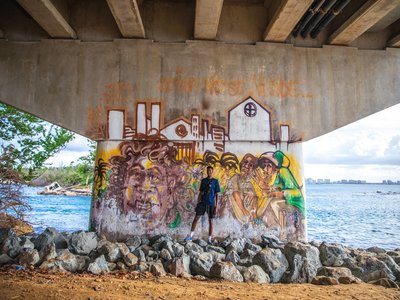
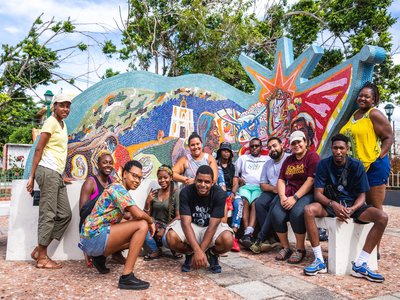

Hi Bob! What inspired you to get involved?
I met Malía (Everette, Founder & CEO of AltruVistas) by chance, through a mutual friend who is the owner of Numi Tea. She found out I was from Puerto Rico and so we started talking about the upcoming delegation with College Track, which at that point was in its planning stages. The nature of the project hit a whole bunch of buttons for me. First of all, I want to do anything that I possibly can to help my island get back up on its feet. I also love New Orleans, and wanted to work with these students and possibly help them. College Track works with historically underrepresented youth, helping to mentor them so they can get into college, and then funding them for up to six years while they earn their BA.
Given my background in clinical psychology, I understood that the Puerto Rico delegation would be a therapeutic project for the students. This proved true. Through the work that they did, it helped them deal with the trauma they’d experienced as kids. They’d all been impacted deeply by Katrina, and now, to be able to give back to those impacted by Maria, it helped them build a sense of resilience.

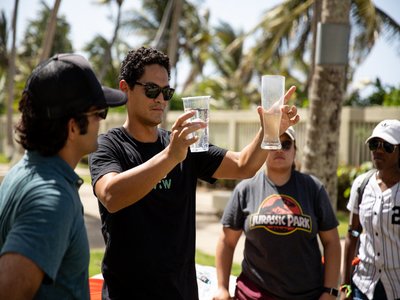
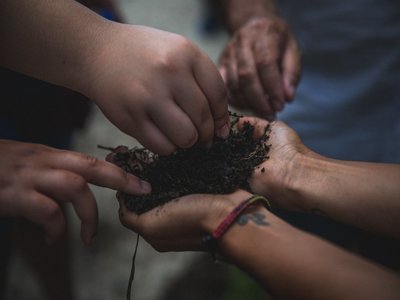
What were some of the restorative local groups and initiatives the delegation worked with? What were some of the projects the students did on the island?
In the coastal town of Salinas, which took practically a direct hit from the Category 4 force hurricane, we painted a community and cultural center called Centro Cunyabe. In the mountain community of Adjuntas, we worked closely with the amazing organization Casa Pueblo to help install solar panels on the roof of a restaurant. We also met with Waves for Water, a company that has created a simple, inexpensive but effective water filtration system. After Maria, most people didn’t have water, because the electricity was out island-wide, and the water pumping system is dependent on electricity. People were drinking river water; whatever they could get their hands on. Waves for Water’s filtration system removes 99% of the organic contaminants without the need for boiling.
We also met with Frutos del Guacabo, and they showed us their hydroponic growing techniques that conserve water and also allow for growing crops outside of the ground. They’re involved in the sustainable, local agriculture movement, producing foodstuffs and herbs that they sell to restaurants. They also have a goat farm where they milk goats for cheese. The corral butts up against a hillside with caves that the goats live in—no need for pens! The students volunteered, helping to pack pineapples and doing some weeding around the crops. Frutos del Guacabo is involved in project called World Central Kitchen that served over a million meals in Puerto Rico post-Maria. That same operation is currently operating in areas impacted by Hurricane Michael, and also helped out in the Carolinas after Hurricane Florence.
Another place we visited that has a similar long-range vision of agricultural sustainability for the island was Brigadas Huerta, the student-led community garden at the University of Puerto Rico. They’re trying to create more independence and transition away from reliance on the mainland US for food. Throughout history, from the colonial period to the 1950s, Puerto Rico was an agricultural society, producing the vast majority of its own food. But due to Operation Bootstrap and the rise of industrialization, now 80-85% of food consumables are imported from the mainland US. Also, the Jones Act was passed in the early 1900s to protect US shipping: Any product other than US products that are sent to Puerto Rico are subject to huge tariffs, thus making them extremely expensive. For example, the Dominican Republic is right next door, but it’s not easy to trade with them. To avoid these extremely high tariffs, the DR is forced to send its exports to Florida, where they are then transferred to a US-owned-and-staffed ship, only to be shipped back to Puerto Rico with the price increased by 15-40%.
In Puerto Rico, we don’t control our ports, our currency, or many of the fundamental decisions that determine in large part our economic policies. We were in a huge financial crisis even prior to the hurricane. It’s a convoluted and complex relationship with the US government. All Puerto Rico political parties organize around what they see as the future political status of the island. The progressive party, which largely lines up with the US Democratic party, are for the status quo of remaining a territory; conservatives advocate for statehood; and there is a growing movement on the left of wanting independence, the “independentistas.”
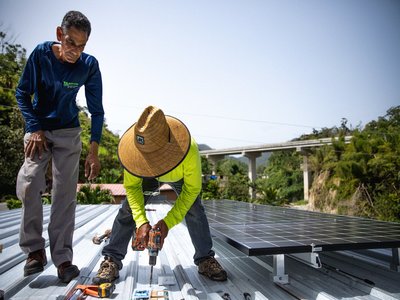

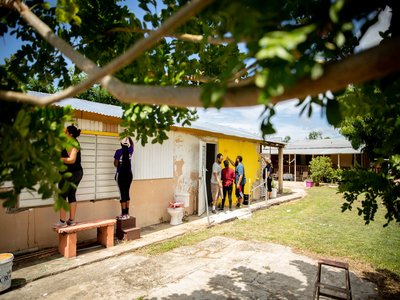
“Our experience with the College Track student volunteers was one of empathy and goodwill. It was a great pleasure to have them with us here at Casa Pueblo. These young kids came here and gave their best to contribute to the recovery of our communities. Their work is evidence of what we can attain through humanitarian response and solidarity. They are now part of a broader effort that is currently transforming our energy reality into one of self-sufficiency and clean resources, building resiliency.”
The group ended up meeting with the mayor of San Juan, Carmen Yulín Cruz Soto. Can you talk about that?
My mom’s side of the family is still on the island and I visit at least two times a year, so I’m pretty dialed in to Puerto Rico. Through family contacts, I was able to connect directly with the mayor and her events secretary. The impression I had was that we were going to have a very brief meet-and-greet and photo op with her. But when we all gathered, the students were asked to share their experiences of Katrina. They had all been between the ages of four and ten when Katrina hit, and their memories were very powerful stories. Then the mayor started to tell her story. She was in a stadium that was set up as a refuge for people because it’s a big strong concrete structure. But the electric and telecommunications went out, and she was completely cut off. She was in charge. “What do I do?” she wondered. She described the sound of the wind, how ferocious it was, and she started tearing up a bit. Then everybody started tearing up. She’s a national figure but the emotional solidarity was there.
Cruz is very much a populist, anti-social-stratification leader: Prior to the hurricane, she had moved her office from an elegant, prominent mayor’s building to a trailer in Luis Muñoz Marín Park. The outside of the office has been painted by local school kids and is covered with images of Puerto Rican plants, animals, and insects. We were invited inside for more informal chatting and so the students could get some fruit juice and snacks. The mayor also wanted to tour us through the community garden there. What was supposed to be a 20 minute photo op with her turned into 90 minutes of an amazing and often emotional exchange.
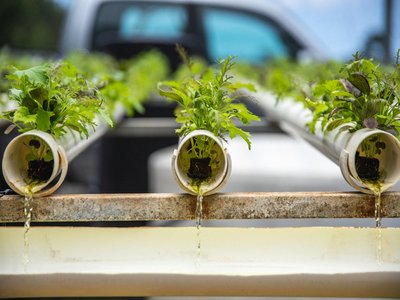
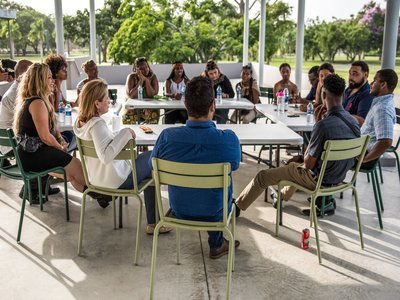

How do you think the delegation journey transformed the students, the Puerto Ricans, and yourself?
To talk about the students, I’ll preface my response by saying that I used to work at the VA Medical Center in Kansas City. There, I learned that the opportunity for people to talk about their experienced trauma is actually the best way of treating post-traumatic distress disorder (PTSD). Medications don’t help: The best way to move through PTSD is to talk about it, get reinforcement, understanding, empathy…. And then little by little, the trauma starts to go away; the impact is reduced. By talking amongst themselves, as well as to us and to the Puerto Ricans, that was exactly what was happening for the students. They know each other from College Track, but they had never spent ten intensive days together, eating all their meals together, socializing together, working together. Plus, many of the students hadn’t traveled much outside of Louisiana before, and they were engaging in transformative travel to a very beautiful place—even if they were seeing a lot of damage too. But we also saw a lot of green shoots. The island is coming back.
For the locals: To see others care enough and show interest—there’s a profound sense of solidarity when that happens. That’s healing for people: We’re not alone. We’re not an island drowning in the middle of the ocean. We have support.
I think for both groups: Even though you may have different food, music, language—you have so many commonalities. And both groups have, unfortunately, experienced substantial under-resourcing by the US government. Both groups experienced an inability to get the needed support due to, in my opinion, the culture of inequity and social injustice that emerges when the US responds to catastrophes experienced in areas primarily populated by people of color. To build a solidarity delegation in the face of that was extremely powerful.
As for myself—I’ve been involved with other social justice projects, but this journey felt really special to me because I was able to get my boots on the ground and get involved with those kinds of activities on my island. I formed really close relationships with the students very quickly. It was also great to become aware of and a part of the work Malía does with AltruVistas.
My birthday was during the trip. We were in Salinas painting Centro Cunyabe, the cultural and community building, and I thought, “Here I am, getting covered in paint on my birthday… and I’m loving it!” It felt good to be involved—healing on so many levels; for my island, for these students. I truly felt that this is what I should be doing at this time and in this place.
“The students were phenomenal and brought the mission of the trip to another level with their own commitment to equity and solidarity. They were able to create an experience of profound impact and connection with communities who are still, almost a year later, feeling deep pain from this natural disaster and the subsequent unnatural series of events that led to greater ripples of injustice. Because the College Track students shared the perspective and strength of the Puerto Ricans, and their commitment to resilience, equity, and self-determination – they made beautiful connections with the groups we worked with on the ground.”
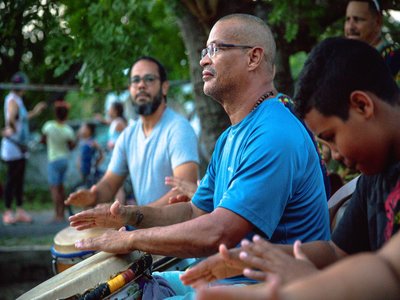
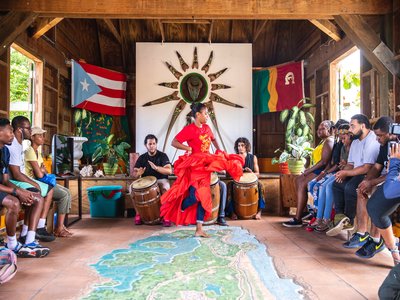

Puerto Rico still has a long way to go to recover. What can folks who are reading this do to help?
As we know, there’s been a total disconnect with the Trump administration. Stay informed. I do think some of the major news outlets such as CNN, CBS, and MSNBC have done a pretty good job of keeping our story alive in the public consciousness.
For those wanting to help: Casa Pueblo is doing amazing work in their community—they’re who we worked with to install the solar panels and help paint the restaurant. They do a lot of work with sustainable energy—for instance, purchasing solar powered refrigerators, some of which are tiny, shoebox-sized and are for people who are insulin-dependent to keep their insulin safe. Casa Pueblo is trying to become self-sustaining; to break the cycle of dependency on the United States. They’re a great boots-on-the-ground, smaller, local organization without the large overhead of some of the international relief organizations, and you can donate directly to them through their site (scroll to bottom of page for donation options). They are also open to volunteers—although they don’t have a formal volunteer program, arrangements can be made with enough advance planning, so contact them directly if interested.
If you want to post on Twitter, Facebook, or Instagram to spread awareness, we’ve been using the hashtag #PuertoRicoSeLevanta, which roughly translates to “Puerto Rico Will Get Back on its Feet.”
One thing you can definitely do to help is come to Puerto Rico for vacation. We’re a visually stunning island with miles of breathtaking beaches, lush tropical mountains, and the cultural jewel of Old San Juan, which is a World Heritage site. The hotel industry is back up and operating. Visiting us brings incredibly-needed dollars back into the local economy.
All photos courtesy Lucas Oswald, Emerson Collective

